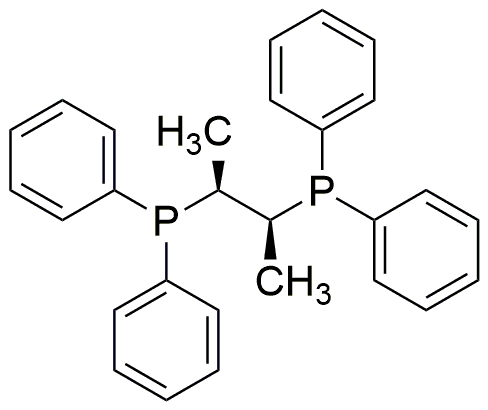(2S,3S)-(-)-Bis(diphenylphosphino)butane is widely utilized in research focused on:
- Catalysis: This compound serves as an effective ligand in transition metal catalysis, enhancing reaction rates and selectivity in various organic transformations, such as cross-coupling reactions.
- Pharmaceutical Development: It plays a crucial role in the synthesis of complex pharmaceutical compounds, allowing for more efficient pathways in drug discovery and development.
- Material Science: The compound is used in the development of advanced materials, including polymers and nanomaterials, where its unique properties can improve performance and stability.
- Environmental Chemistry: It aids in the development of catalysts for environmental applications, such as pollution control and waste treatment, contributing to more sustainable practices.
- Research and Academia: This chemical is a valuable tool in academic research, providing insights into coordination chemistry and the behavior of metal complexes, which can lead to innovative discoveries.
General Information
Properties
Safety and Regulations
Applications
(2S,3S)-(-)-Bis(diphenylphosphino)butane is widely utilized in research focused on:
- Catalysis: This compound serves as an effective ligand in transition metal catalysis, enhancing reaction rates and selectivity in various organic transformations, such as cross-coupling reactions.
- Pharmaceutical Development: It plays a crucial role in the synthesis of complex pharmaceutical compounds, allowing for more efficient pathways in drug discovery and development.
- Material Science: The compound is used in the development of advanced materials, including polymers and nanomaterials, where its unique properties can improve performance and stability.
- Environmental Chemistry: It aids in the development of catalysts for environmental applications, such as pollution control and waste treatment, contributing to more sustainable practices.
- Research and Academia: This chemical is a valuable tool in academic research, providing insights into coordination chemistry and the behavior of metal complexes, which can lead to innovative discoveries.
Documents
Safety Data Sheets (SDS)
The SDS provides comprehensive safety information on handling, storage, and disposal of the product.
Product Specification (PS)
The PS provides a comprehensive breakdown of the product’s properties, including chemical composition, physical state, purity, and storage requirements. It also details acceptable quality ranges and the product's intended applications.
Certificates of Analysis (COA)
Search for Certificates of Analysis (COA) by entering the products Lot Number. Lot and Batch Numbers can be found on a product’s label following the words ‘Lot’ or ‘Batch’.
*Catalog Number
*Lot Number
Certificates Of Origin (COO)
This COO confirms the country where the product was manufactured, and also details the materials and components used in it and whether it is derived from natural, synthetic, or other specific sources. This certificate may be required for customs, trade, and regulatory compliance.
*Catalog Number
*Lot Number
Safety Data Sheets (SDS)
The SDS provides comprehensive safety information on handling, storage, and disposal of the product.
DownloadProduct Specification (PS)
The PS provides a comprehensive breakdown of the product’s properties, including chemical composition, physical state, purity, and storage requirements. It also details acceptable quality ranges and the product's intended applications.
DownloadCertificates of Analysis (COA)
Search for Certificates of Analysis (COA) by entering the products Lot Number. Lot and Batch Numbers can be found on a product’s label following the words ‘Lot’ or ‘Batch’.
*Catalog Number
*Lot Number
Certificates Of Origin (COO)
This COO confirms the country where the product was manufactured, and also details the materials and components used in it and whether it is derived from natural, synthetic, or other specific sources. This certificate may be required for customs, trade, and regulatory compliance.


